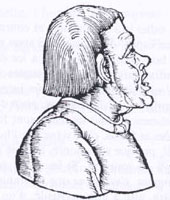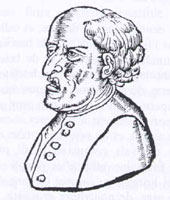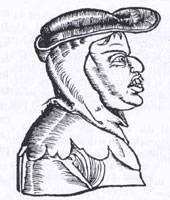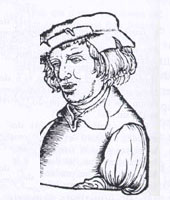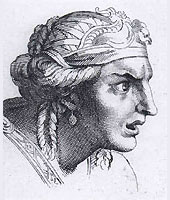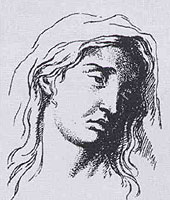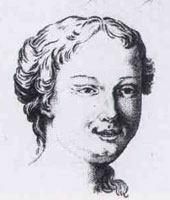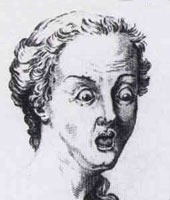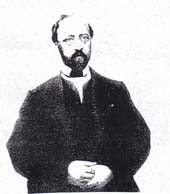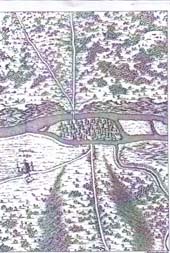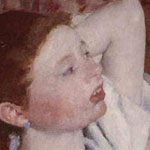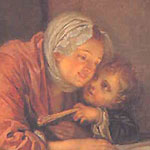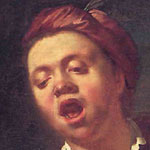Current Research
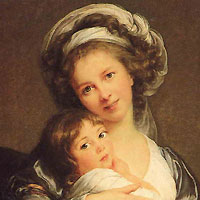 |
a) The French Smile Revolution: Identity and Dentistry in 19th-century Paris
The seilf-portrait of Madame Vigée-Lebrun, exhibited in the Paris Salon in 1787, and showing her smiling with open mouth and white teeth, was vehemently criticised as scandalous. |
The smile broke artistic conventions regarding the depiction of the open mouth. According to conventions originating in Antiquity and recodified by Charles Le Brun in the seventeenth century, the open mouth in western art was invariably accompanied by bad teeth and signified that an individual was plebeian, insane, grotesque or else the subject of extreme passion. It is thus interesting to ask why this change of artistic conventions changed when it did - and also to explore whether this apparent smiling revolution was linked to wider social and cultural shifts.
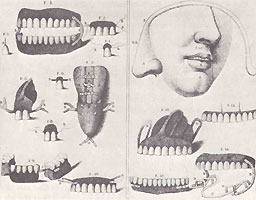 |
I am seeking to pursue these questions in a number of areas besides the history of painting. These include the history of science and medicine (e.g. the state of French teeth, hygienic and sanitary practices, the emerging prestige of dental surgery), the history of professionalism (esp. the declining prestige of the toothpuller and the emergence of the dentist), the history of commercialism (advertisement for mouth-care products ranging from tongue-scrapers to false teeth), the history of technology, including technologies of the self (e.g. teeth-cleaning, smiling). |
The project focuses on the 'long eighteenth century' from the late seventeenth through to the early nineteenth century. A particular ambition is to connect the social and cultural transformation of the smile to the political events of the Revolutionary decade - in a way which will owe something to Antoine de Baecque's work on the history of laughter.
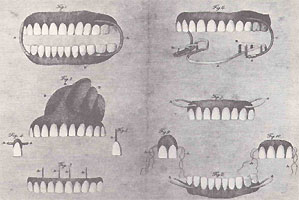
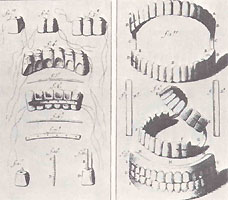
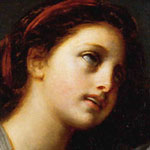 |
|
b) Physiognomy and the History of the Face
My work on the cultural history of the smile has led me to extend research i to more general consideration of the history of the face. From 2007, I have been principal investigator on a 3-year Leverhulme International Network Grant on The History of Physiognomy, 1500-1850. Co-investigators on the project are Professor Lina Bolzoni (Scuola Normale Superiore, Pisa) and Nadeije Laneyrie-Dagen (École Normale Supérieure, Paris), and the Network Facilitator is Delphine Doucet (QMUL). Conferences have been held in Paris (2006) and London) with a third planned for Pisa in 2010. The project website may be visited at http://physiognomy.history.qmul.ac.uk/
The research is also explored in my undergraduate course 'The Face in Western Medicine and Culture from the Renaissance to Freud.' The course handbook can be viewed at http://webspace.qmul.ac.uk/cdhjones/index.html
c) The History of Caricature and Laughter
From 2007, I have been principal investigator on a three-year Arts and Humanities Research Council Project, The Saint-Aubin Project: The Livre de caricatures tant bonnes que mauvaises. Co-investigators are Juliet Carey and Pippa Shirley, from the curatorial staff at Waddesdon Manor. The PDRA on the project is Emily Richardson.
The Project aims to digitise the contents of a book of caricatures drawn between the 1740s and the 1770s by members of the Saint-Aubin family and their friends, but particularly by Charles-Germain de Saint-Aubin. The book of caricatures is festive and jolly, but also more than mildly subversive and often rude and scatalogical (the brothers called it their 'livre de culs' their 'book of arses'). The book was intended to make its readers laugh, but that was necessarily a small group, as the subversive nature of its contents would have led to their likely imprisonment had the work become widely known.
The digitised contents of the book will in 2010 be placed on the Waddesdon Manor website, together with a critical edition of the text on which the research team is currently working. There will be an intenational seminar on the work in 2009, and a book of essays arising from the conference in 2010 or 2011.
I have given a number of presentations at conferences and seminars on the topic, and am becoming interested in the history of laughter.
d) The History of Emotions
My work on the history of the face, and on caricature and laughter, have led me towards the burgeoning area of the history of the emotions. My own major concern relates to the facial expression of emotion, and laughter. I am a member of the Centre for the History of the Emotions, based in the QMUL History Department (Director: Thomas Dixon). The Centre’s website may be visited at http://www.history.qmul.ac.uk/research/Centre%20for%20the%20History%20of%20the%20Emotions/index.html
e) 9 Thermidor Year II
I am beginning a new research project on 9 Thermidor Year II (27 July 1794), when Maximilien Robespierre and his allies were deposed from the Committee of Public Safety.
The day was evidently an important one in the life of Robespierre himself (he was executed the next day), and an important one in the history of the Revolution. It is usually accounted the turning point at which the Revolution abandoned the policy of systematic terror which it had been following for a year or more. My aim is to do justice to these two perspectives but also to explore what the meaning of the day in the history of Paris. This perspective has been neglected in recent historiography.
Since 1789, the people of Paris had been a major actor in Revolutionary action. On this day, when circumstances permitted them to support Robespierre and to overthrow his enemies, their support was notably by its absence. To understand this, we need to know not just about the policies of the Committee of Public Safety towards Paris, but also to investigate in some detail how revolutionary crowd action was played out on the streets of Paris. How did news travel? What was the role of rumour and gossip? How were people mobilised? And de-mobilised? Did logistical and spatial factors determine the people of Paris’s limited response during the day?
The project will eventuate in articles to be placed in learned journals, and in a book manuscript. A Small Grant from the British Academy (2008-10) under the theme, 9
Thermidor: 24 Hours of Parisian Revolution is enabling me to collect material for the project from Parisian libraries and archives.
f) Historiographical Themes
I have been publishing extensively in recent years on topics which cover the historiography as well as the history of my major areas of research. Published work includes, on my List of Publications.
I have been drawn into working in this area particularly as a result of invitations to contribute to conferences, journals and essay collections. The field covered relates to cultural and social history, the history of medicine, and French (and especially French Revolutionary) history. My main current and recent work in this field is as follows:
In 2004, I contributed to a discussion of cultural history which was carried in the early issues of the new journal, Cultural and Social History, vol. 1. My critique of an article by Peter Mandler appeared as 'Peter Mandler's Problems with Cultural History, or Back to the Playground?'
Michel Vovelle as historian of the French Revolution. Roundtable on Vovelle's work at the 2004 Paris Conference of the US Society for French Historical Studies. Published in French History in 2005.
Olwen Hufton and Richard Cobb as historians of 'the people' and 'the poor' within French Revolutionary historiography. Paper given at a conference held to honour Olwen Hufton in Oxford in 2004. The revised and extended paper will appear as a book chapter in a collection of essays, The Art of Survival. Essays in Honour of Olwen Hufton, to be edited by Ruth Harris and Lyndal Roper, to be published by Oxford University Press as Past & Present Supplements 1.
Mirko Grmek and the idea of the longue durée in the history of medicine. This sprang out of a paper I prepared for a conference in memory of Grmek's work at the UCL Wellcome Centre for the History of Medicine, London, in 2002. The influence of the Annales, and particularly the Braudelian notion of longue durée is central to my paper on Hufton and Cobb, and consideration of Grmek's work offers another field in which the notion can be examined. The revised paper 'The Pathocenosis Moment: Mirko Grmek, the Annales and the Vagaries of the Longue Durée', has appeared in Journal of the History and Philosophy of Science in 2005.
The work of Gérard Noiriel. I presented a paper on the latter's recent book, Penser pour, penser contre, which was held at the École Normale Supérieure in Paris in 2003. The article, 'Sur la crise de l'histoire II? (A propos de Gérard Noiriel, Penser pour, penser contre'), appeared in the Revue d'histoire moderne et contemporaine, in 2005.
Current work in progress includes
- A review article on the history of the body, to appear in Past and Present
- A short article for French Historical Studies on the historiography of the French
- Revolution in the two decades since the bicentenary of 1989
- An edited collection devoted to the relationship between Charles Dickens’ A Tale of Two Cities and the French Revolution. Some of the themes are explored in the ‘Introduction’ to the collection of essays I am co-editing with Josephine McDonagh and Jon Mee, entitled Charles Dickens, The Tale of Two Cities and the French Revolution (Palgrave Macmillan, forthcoming). (List of Publications http://webspace.qmul.ac.uk/cdhjones/publications.html .)
- Explorations of the history of France as viewed from England, through the perspective of histoire croisée. This will be the chosen them of my Presidential lectures for the Royal Historical Society between 2009 and 2012, which will be published in the Transactions of the Royal Historical Society.
